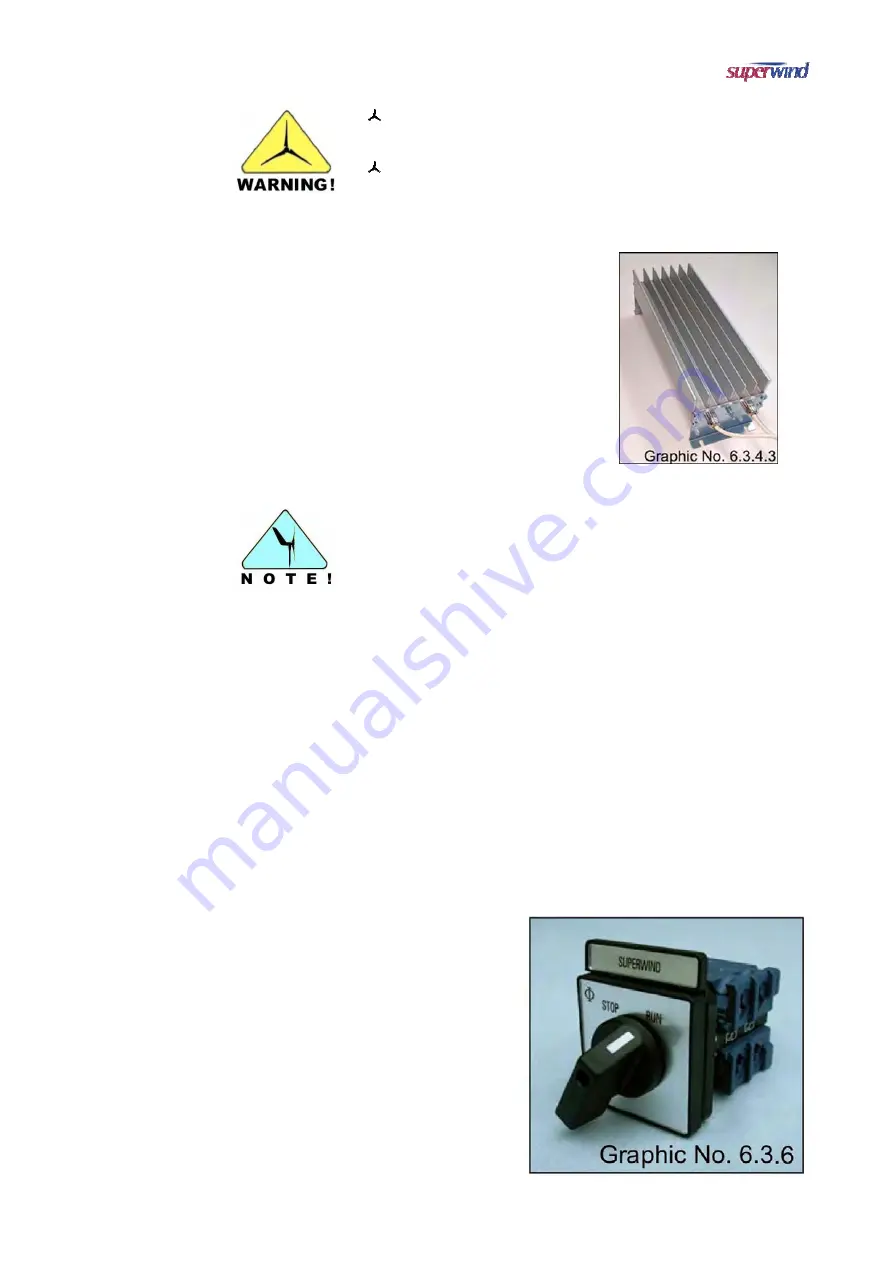
V 01-2017
www.superwind.com
25
The charge regulators are not protected against interchanged
polarity of the lines (wires) and would be damaged in a
reversed polarity situation.
If you want to use a different charge regulator other than the
one described here, make sure that it is a shunt-regulator.
6.3.4.3
Diversion Load Resistor
The resistance of the cable that
connects the load resistor with the
charge regulator can affect the
charging voltage. Therefore, the
connecting resistor wire run should
not exceed 1 meter with the
recommended wire gauge. If you
would like to extend the resistor
wire beyond 1 meter, please refer to
the AWG Wire Size Chart (Table
No. 6.3.1.1 and 6.3.1.2).
The series controllers (sometimes called Solar Charge
Controllers/Regulators) often used in photovoltaic systems are
unsuitable. They interrupt the electric circuit for voltage
regulation, which would allow the wind generator to run in no-
load operation. Additionally, the charge regulator must be laid
out for electric flows of at least 40 A (12 V version) or 20 A (24 V
version).
6.3.5 Fuses
To protect the battery against short-circuits
,
fuses must be installed in the
POSITIVE line between the wind generator and the battery and in the
POSITIVE line between the battery and the charge regulator. (See
Graphic No. 6.2.1.1 on Page 18). The fuses are 40 ampere slow-blow
type (12 V-system), 20 ampere slow-blow type (24 V-system), or
appropriate automatic circuit breakers.
Fuses must be placed as close to the battery as possible, however they
cannot be installed within the same compartment. Unsealed lead-acid
batteries have vent holes which release hydrogen that mixes with the
ambient air to create a potentially explosive mixture. The spark generated
by a blowing fuse (or release of an automatic circuit breaker) can detonate
this explosive gas mixture.
6.3.6 Stop
switch
The stop switch is used to
shut down the wind
generator operation or to
prevent starting of the rotor
during maintenance, repairs,
or when working in the
turbine operational area.
When using the
Superwind on a boat or a
sailing yacht, installation
of a stop switch is
strongly recommended to
Summary of Contents for 350 12V
Page 1: ...www superwind com Superwind 350 12V 24V Manual North Central and South America regions 01 2017...
Page 2: ...V 01 2017 www superwind com 1 Page intentionally left blank...
Page 52: ...V 01 2017 www superwind com 51 ATTACHMENT A Stop Switch Mounting Guidelines...
Page 53: ...V 01 2017 www superwind com 52 STOP SWITCH Mounting Guidelines Manual 01 2017...
Page 60: ...V 01 2017 www superwind com 59 ATTACHMENT B Superwind Charge Regulator 12V Marine...
Page 61: ...V 01 2017 www superwind com 60 Charge Regulator 12V Marine Instructions Manual 01 2017...
Page 70: ...V 01 2017 www superwind com 69 ATTACHMENT C Superwind Charge Regulator 24V Marine...
Page 71: ...V 01 2017 www superwind com 70 Charge Regulator 24V Marine Instructions Manual...






























